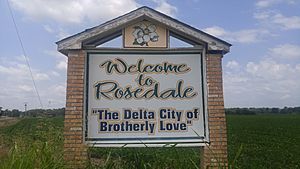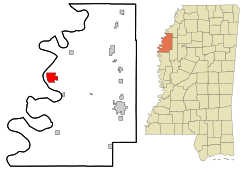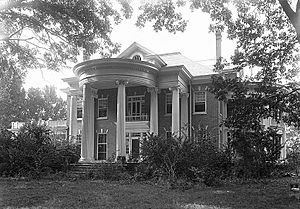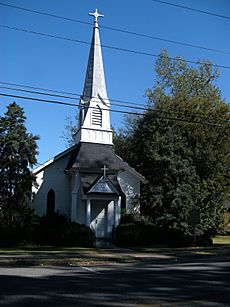Rosedale, Mississippi facts for kids
Quick facts for kids
Rosedale, Mississippi
|
|
|---|---|
|
City
|
|
 |
|
| Motto(s):
The Delta City of Brotherly Love
|
|

Location of Rosedale, Mississippi
|
|
| Country | United States |
| State | Mississippi |
| County | Bolivar |
| Area | |
| • Total | 5.48 sq mi (14.19 km2) |
| • Land | 5.42 sq mi (14.02 km2) |
| • Water | 0.06 sq mi (0.16 km2) |
| Elevation | 138 ft (42 m) |
| Population
(2020)
|
|
| • Total | 1,584 |
| • Density | 292.52/sq mi (112.95/km2) |
| Time zone | UTC-6 (Central (CST)) |
| • Summer (DST) | UTC-5 (CDT) |
| ZIP code |
38769
|
| Area code(s) | 662 |
| FIPS code | 28-63720 |
| GNIS feature ID | 2404649 |
Rosedale is a city in Bolivar County, Mississippi, USA. In 2020, about 1,584 people lived there. Rosedale is in a farming area. It used to have a train station for the Yazoo and Mississippi Valley Railroad. This train helped many people travel north in the early 1900s.
Contents
History of Rosedale
Rosedale was first settled around 1838. It became one of the two main county towns in 1872. This area was known for large cotton farms. These farms relied on enslaved people for labor.
After the Civil War, many formerly enslaved people bought land. They became landowners before the 1900s. However, by 1910, many Black landowners in Mississippi lost their land. This was due to a long economic downturn and changing political conditions. They found it hard to compete with new railroads. These railroads started being built in the area in 1882. Many people stayed to work as sharecroppers. The railroad brought new business to Rosedale. It had a depot where cotton was shipped to other markets. Rosedale officially became a town on February 2, 1882. It became a city in 1930.
The Great Migration and Blues Music
In the early 1900s, many Black people left Mississippi. This was part of the Great Migration. They traveled north by train to cities like Chicago. Others went to California for defense jobs during World War II. Still, many families chose to stay in Rosedale.
In 2007, a special marker was placed in Rosedale. It's at the old train station site. This marker is part of the Mississippi Blues Trail. It honors places mentioned in blues songs. For example, the famous blues artist Robert Johnson sang about this area. His song "Travelling Riverside Blues" mentions the railway route. This route went from Friars Point to Rosedale. It also included stops like Vicksburg and Memphis.
The marker shows how trains were important in blues songs. They often stood for travel and escaping hard times. Another blues theme was life near a river. This can be heard in Charlie Patton's song "High Water Everywhere".
Some local stories say that Robert Johnson made a deal with the Devil. This supposedly happened in Rosedale. It was at the crossing of Mississippi highways 1 and 8. People say he sang about this in his song "Cross Road Blues." This story was even mentioned in the TV show Supernatural. However, other towns in the Delta also claim this event happened near them.
Geography and Location
Rosedale is located about 19 miles (31 km) northwest of Cleveland.
The United States Census Bureau says Rosedale covers about 5.48 square miles (14.2 km2). Most of this area is land. Only a small part, about 0.06 square miles (0.16 km2), is water.
Rosedale is on the east side of the Mississippi River. It is roughly halfway between where the Arkansas and White rivers flow into the Mississippi. These two rivers join the Mississippi from the Arkansas side.
Population and People
| Historical population | |||
|---|---|---|---|
| Census | Pop. | %± | |
| 1890 | 376 | — | |
| 1900 | 622 | 65.4% | |
| 1910 | 1,103 | 77.3% | |
| 1920 | 1,696 | 53.8% | |
| 1930 | 2,117 | 24.8% | |
| 1940 | 2,063 | −2.6% | |
| 1950 | 2,197 | 6.5% | |
| 1960 | 2,339 | 6.5% | |
| 1970 | 2,599 | 11.1% | |
| 1980 | 2,793 | 7.5% | |
| 1990 | 2,595 | −7.1% | |
| 2000 | 2,414 | −7.0% | |
| 2010 | 1,873 | −22.4% | |
| 2020 | 1,584 | −15.4% | |
| U.S. Decennial Census | |||
Rosedale's Population in 2020
| Race | Num. | Perc. |
|---|---|---|
| White | 140 | 8.84% |
| Black or African American | 1,395 | 88.07% |
| Native American | 1 | 0.06% |
| Other/Mixed | 30 | 1.89% |
| Hispanic or Latino | 18 | 1.14% |
In 2020, there were 1,584 people living in Rosedale. These people lived in 642 households. About 398 of these households were families.
Education in Rosedale
Schools in Rosedale are part of the West Bolivar Consolidated School District. Students attend West Bolivar Elementary School, West Bolivar Middle School, and West Bolivar High School.
A very important court case, Gong Lum v. Rice, started in Rosedale. In this case, the U.S. Supreme Court decided that a Chinese student could not go to the school for white children. Instead, she had to attend the school for "colored" children.
Famous People from Rosedale
- Travarus Bennett, a former professional basketball player
- Dennis Binder, a rhythm & blues musician and singer
- Joseph Henry Bufford, a state lawmaker
- Redd Holt, a jazz and soul music drummer
- Percy Malone, an Arkansas politician and pharmacist
- Cliff Meely, a professional basketball player
- W. B. Roberts, a lawyer, farmer, banker, and political leader
- Walter Sillers, a lawyer and farmer
- Walter Sillers, Jr., a lawyer and political leader
- Florence Sillers Ogden, a newspaper writer
- Florence Warfield Sillers, a historian
See also
 In Spanish: Rosedale (Misisipi) para niños
In Spanish: Rosedale (Misisipi) para niños




